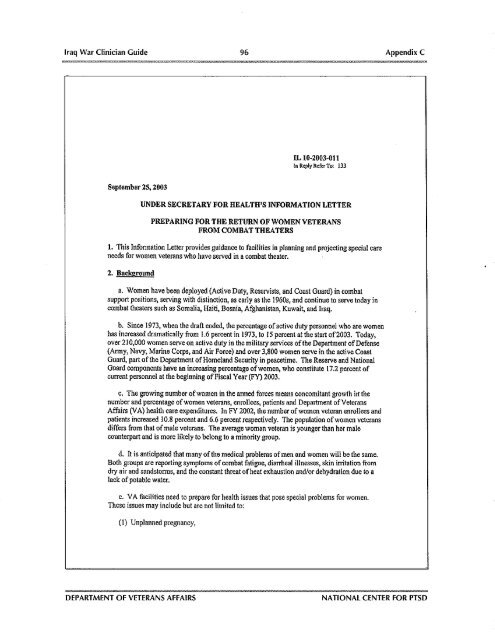IRAQ WAR CLINICIAN GUIDE
Iraq War Clinician's Guide - Network Of Care
Iraq War Clinician's Guide - Network Of Care
Create successful ePaper yourself
Turn your PDF publications into a flip-book with our unique Google optimized e-Paper software.
Iraq War Clinician Guide 96 Appendix C<br />
IL 10-2003-011<br />
In Rcply Rcfc~Tw 133<br />
September 25,2003<br />
UNDER SECRETARY FOR HEALTH'S INFORMATION LETTER<br />
PREPARING FOR THE RETURN OF WOMEN VETERANS <br />
FROM COMBAT THEATERS <br />
1. This Infonnation Lettcr provides guidance to facilities in planning and projecting special care<br />
needs for women veterans who have served in a combat theater.<br />
2. Backeround<br />
a. Women have been deployed (Active Duty, Reservists, and Coast Guard) in cotnhat<br />
support positions, serving with distinction, as early as thc 1960~~ and continue to serve today in<br />
combat theaters such as Somalia, Haiti, Bosnia, Afghanistan, Kuwait, and Iraq.<br />
b. Since 1973, when the draft ended, the percentage of active duty personnel who are women<br />
has increased dramatically from 1.6 percent in 1973, to 15percent at the start of2003. Today,<br />
over 210,000 women serve on active duty in the military services ofthe Department of Defense<br />
(Army, Navy, Marille Corps, and Air Force) and over 3,800 women serve in thc active Coast<br />
Guard, part of the Department of Homeland Security in peacetime. Tl~e Reserve and Nntionnl<br />
Guard components have an increasing percentage of women, who constihlte 17.2 percent of<br />
current personnel at the beginning of Fiscal Year (FY)2003.<br />
c. The growing number of womm in the armed forces means concomitant growth in the<br />
number and percentage of women veterans, enrollees, patients and Department of Veterans<br />
Affairs (VA) health care expenditures. In FY 2002, the number of women veternn enrollees and<br />
patients increased 10.8 percent and 6.6 percent respectively. The population of women veterans<br />
differs from that of male veterans. The average woman veteran is younger than her male<br />
counterpart and is more likely to belong to a minority group.<br />
d. It is anticipated that many of tile medical problems of men and women will be the same.<br />
Both groups are reporting symptoms of combat fatigue, diarrheal illnesses, skin initation tiom<br />
dry air and sandstorms, and the constant threat of heat exhaustion andlor dehydntion due to a<br />
lack of potable water.<br />
c. VA facilities need to prepare for health issues that pose special problems for women.<br />
Thcse issues may include but arc not limitcd to:<br />
(I) Unplanned premancy,<br />
DEPARTMENT OF VETERANS AFFAIRS<br />
NATIONAL CENTER FOR PTSD




